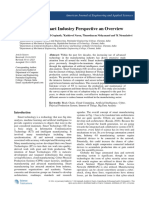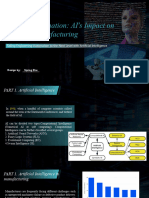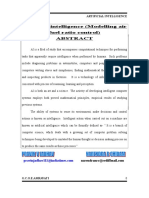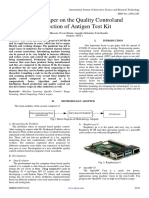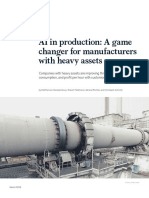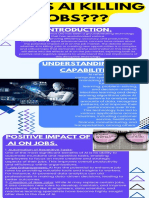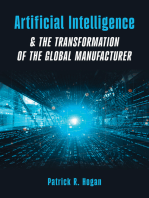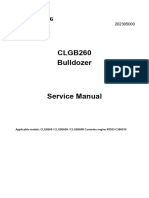Professional Documents
Culture Documents
Intelligent Engines: Revolutionizing Manufacturing and Supply Chains With AI
Intelligent Engines: Revolutionizing Manufacturing and Supply Chains With AI
Original Title
Copyright
Available Formats
Share this document
Did you find this document useful?
Is this content inappropriate?
Report this DocumentCopyright:
Available Formats
Intelligent Engines: Revolutionizing Manufacturing and Supply Chains With AI
Intelligent Engines: Revolutionizing Manufacturing and Supply Chains With AI
Copyright:
Available Formats
Volume 9, Issue 4, April – 2024 International Journal of Innovative Science and Research Technology
ISSN No:-2456-2165 https://doi.org/10.38124/ijisrt/IJISRT24APR1221
Intelligent Engines: Revolutionizing
Manufacturing and Supply Chains with AI
Vishwanadham Mandala1; Manogna Dolu Surabhi2
Abstract:- Artificial intelligence (AI) technologies are
becoming a reality, with intelligent engines that can
learn and simulate human thinking. These engines have
three key features: micro-level intelligence with sensors,
logic-based intelligence with software tools, and the
ability to adapt and learn using algorithms. AI reduces
the need for human intervention and cognitive thinking,
finding more efficient solutions to complex problems in
manufacturing and supply chain industries. AI simulates
human cognition using software tools, allowing for the
automation of tasks and analysis of complex systems.
However, it raises questions about whether problems can
be solved differently and the limitations of explicit
algorithms.
Fig 2: The Industrial Revolution
Keywords:- Intelligent Engines, Supply Chain, Industry 4.0,
Internet of Things (IoT), Artificial Intelligence (AI), A. Background
AI is a technology that imitates intelligent behavior
Machine Learning (ML), Smart Manufacturing (SM).
and has widespread applications in manufacturing. It
enhances data analysis and reduces machinery upkeep costs.
I. INTRODUCTION
AI can be used for preventative maintenance and developing
systems that maximize goal achievements. Like analyzing
This book focuses on the design of 'intelligent' engines,
using modern Information Technology (IT) to automate vehicle downtime statistics, intelligent engines can
revolutionize manufacturing and supply chains. Caterpillar's
tasks currently done by humans. The goal is to have a cost
research showed that AI can be used to configure machine
or performance advantage over alternative automation
systems for more reliable products. This is advantageous for
methods. The field chosen for examination is optimization,
which involves finding the best solution to a problem by reconfiguring production machinery and improving end-
minimizing a cost function. The book aims to develop product quality and reliability.
general methods applicable to specific problems, with a
single application example being manufacturing process
automation. This choice allows for using proven methods
that are familiar to most readers.
Fig 1: The Industrial Revolution – Scientific View
Fig 3: Supply Chain Starts With Shop Floor
IJISRT24APR1221 www.ijisrt.com 489
Volume 9, Issue 4, April – 2024 International Journal of Innovative Science and Research Technology
ISSN No:-2456-2165 https://doi.org/10.38124/ijisrt/IJISRT24APR1221
B. Purpose of the Research C. Scope and Limitations
A theoretical module is proposed to facilitate more This paper will focus specifically on artificial narrow
proactive and autonomous decision-making by individual intelligence (ANI) to ensure an accurate understanding of
factories and their network partners in supply network AI's capabilities and potential impacts. ANI has already
design and planning. This module leverages artificial revolutionized the manufacturing industry, as seen in the
intelligence planning methods to provide a detailed network robotic automation of assembly lines. The scope of this
configuration and the associated operational plan. Past work paper will be confined to AI's impacts on improving or
on supply network design and planning has laid the restructuring the current processes of manufacturing
foundation for this research. However, a significant gap still consumer goods, utilizing the example of an intelligent
needs to be found between the complexity of real-world engine developed by a fictional company.
supply networks and the decision-making capabilities of
managers. This research takes a first step towards providing Table 1: AI and Prior AI Trends/Key
tools to automate the more routine aspects of supply Improvement in Timelines
network decision-making, freeing human managers to focus 1900-1950 Electrification & Industrial Controllers
on more strategic and creative problem-solving. Said 1970-1980 Hardware explosion key to point
another way, the goal is not to replace human decision- 1990-2000 Internet
makers but to make them more effective by automating 2010-2020 Manufacturing Automation, AI, ML
routine decisions and providing intelligent decision support 2020-2024 Rapid Growth – LLM’s
at all levels of the supply network. In pursuing this goal,
specific scope and limitations must be set. II. THE ROLE OF AI IN MANUFACTURING
The manufacturing environment is a perfect platform
for understanding how AI can add learning and decision-
making capabilities to complex tasks. There are many well-
developed AI techniques that have the potential to be
integrated into the manufacturing system. These techniques
include:
Case-based reasoning for new product design and
recycling knowledge from past cases.
Intelligent scheduling optimizes resource use and
minimizes make pan under production environment
constraints. Expert planning and rescheduling perform
production activities in a more complex environment.
Monitoring and diagnostics are used to detect the
tolerance process, and facility monitoring is used to
anticipate system failure.
Autonomous design to self-develop software design
Fig 4: Industrial AI is Revolutionizing Manufacturing tools that are designed to improve software weaknesses
and many more.
Fig 5: Significance of AI in Manufacturing
IJISRT24APR1221 www.ijisrt.com 490
Volume 9, Issue 4, April – 2024 International Journal of Innovative Science and Research Technology
ISSN No:-2456-2165 https://doi.org/10.38124/ijisrt/IJISRT24APR1221
Table 2: AI-Enhanced/Enabled Supply Chain Management Process
Technology Role in SCM Benefits in SCM
Cloud Computing and Storage Enables integrated and seamless data storage Improves operational efficiency and
and access speed of data access and analysis
Inventory and Facilitates efficient management and Reduces inventory costs, improves
Network Optimization Tools distribution of inventory. customer service
Used for tracking and identification of goods
within the supply chain
Sensors and Automatic Automates tasks such as demand planning, Improves tracking accuracy and security
Identification inventory management, and product in the supply chain
development.
Used in warehousing operations, production
lines, and transport.
Enables real-time visibility across the supply
chain
Artificial Intelligence Allows for anticipation of demand fluctuations Improves efficiency, accuracy, and cost
Robotics and Automation and optimization of resources. savings.
Provides opportunities for onsite production, Increases productivity, reduces labor
reducing the need for transportation and storage costs,improves decision-making,
increases the speed of delivery
Industrial Internet-of-Things (IoT) Used for transportation of goods within and Reduces transportation and storage costs
Predictive and between facilities. andallows for customization of products.
Prescriptive Analytics, Enhances real-time communication and Improves delivery speed andreduces
Autonomous Vehicles and Drones information access in the supply chain transportation costs and human errors.
A. Automation and Efficiency Machine shops and manufacturing businesses may still
Once a business decides to manufacture, its primary need to start using outdated processes and methods.
goal is to stay competitive. Growth and profit drive the However, this may not continue due to the retiring skilled
business, leading to increased pressure for better and workers and the fewer younger workers interested in the
cheaper products. Small and medium-sized businesses need field. Increased competition and material costs also make
help investing in large-scale production lines to meet current processes less effective. Intelligent software and AI
production demands. However, computer-aided can offer a solution by optimizing processes like high-speed
manufacturing and intelligent software have overcome this machine-making, reducing cycle time without requiring
issue and provide efficient solutions. These tools are crucial costly changes in the entire process. Due to limited time and
for thriving businesses and avoiding closure due to market resources, this ability to improve existing processes is highly
decline. sought after.
Table 3: Automation Advantages
B. Predictive Maintenance the aerospace and defense industries, resulting in significant
Intelligent AI engines increase downtime intervals by savings and prevention of engine removals. Companies like
implementing predictive maintenance strategies. AI uses Delta Airlines and American Airlines use predictive
statistical analysis, supervised learning, and unsupervised maintenance systems to improve operational efficiencies.
learning methods to forecast system failures. This approach Predictive maintenance's success and cost efficiency will
differs from preventive maintenance and saves on costs. make current manufacturing methods appear outdated.
Implementing predictive maintenance has been prevalent in
IJISRT24APR1221 www.ijisrt.com 491
Volume 9, Issue 4, April – 2024 International Journal of Innovative Science and Research Technology
ISSN No:-2456-2165 https://doi.org/10.38124/ijisrt/IJISRT24APR1221
Fig 6: Predictive Maintenance
C. Quality Control
The second most significant cited problem was
manufacturers' inability to utilize the information available
to them to make informative decisions, with a third of
manufacturers saying data needed to be more bulky and
complex to manage. AI can help manufacturers sift through
this data to detect patterns, diagnose issues, and recommend
action.
Fig 7: Quality Control Equation Fig 8: Quality Control
This has the potential to improve quality, prevent D. Supply Chain Optimization
costly defects, and reduce rework, an area where Supply chains are vital but complex and fragile. AI can
manufacturers currently need help to make informed predict and solve problems, like disruptions and risks. IBM's
decisions using inductive problem-solving. 30% of AI early Watson Supply Chain and UPS's ORION platform are
adopters in manufacturing are using or planning to use AI examples. They optimize routes and offer responsive
for predictive maintenance, compared to only 6% of systems. AI can also simulate and predict cash flow impacts.
manufacturers overall, which tells of AI's potential to AmBev and AB InBev's case showed the risks of extending
improve maintenance activities and shift away from the payment terms. AI estimated a cost of US$200 million for
current cost-intensive run-to-fail maintenance strategy. AB InBev and risk to relationships with small suppliers and
farmers.
IJISRT24APR1221 www.ijisrt.com 492
Volume 9, Issue 4, April – 2024 International Journal of Innovative Science and Research Technology
ISSN No:-2456-2165 https://doi.org/10.38124/ijisrt/IJISRT24APR1221
Fig 9: Supply Chain Optimization
III. INTELLIGENT ENGINES: TRANSFORMING path_to_save (str): Local path where the dataset should
MANUFACTURING PROCESSES be saved.
"""
ML techniques are used in manufacturing. IBM's api = KaggleApi()
Watson, a well-known ML application, optimizes its api.authenticate()
function as a Quality Engineer. ML algorithms predict api.dataset_download_files(dataset_name,
machinery failure and reduce costs. Ecolab used ML to path=path_to_save, unzip=True)
analyze soil loading, resulting in reduced costs.
Manufacturers are increasingly using analytics and AI. def load_data(file_path):
CEOs plan to integrate cognitive computing/AI for various """
purposes in the next 3-5 years. Function to load the data from a CSV file.
Args:
Machine learning is AI that improves prediction file_path (str): Path to the CSV file.
accuracy without explicit programming. Algorithms use """
input data and statistical analysis to predict outcomes. There import pandas as pd
are three types of learning: supervised, unsupervised, and return pd.read_csv(file_path)
reinforcement.
if __name__ == '__main__':
Machine learning technologies are already being used # Define the dataset and path
effectively in manufacturing and can only become more dataset = 'username/dataset-name' # Example:
prevalent in the future. The study "The Learning Enterprise" 'username/manufacturing-engine-data'
sponsored by Accenture, and authored by Sam Khan, states save_path = './dataset'
that top executives believe machine learning can generate file_name = 'data.csv' # Adjust based on actual file
substantial value in terms of increased productivity, higher name in the dataset
efficiency, and lower operational costs.
# Download the dataset
A. Machine Learning Algorithms -Data Collection download_dataset(dataset, save_path)
Data Collection Code sudo code snippets are provided
below. # Load the data
data = load_data(os.path.join(save_path, file_name))
import requests print(data.head())
import os
from kaggle.api.kaggle_api_extended import KaggleApi # Author: Vishwanadham Mandala
def download_dataset(dataset_name, path_to_save): # Date: 2024-04-14
""" Code 1.Python data collection program
Function to download dataset using Kaggle API.
Args:
dataset_name (str): Full path of the dataset on Kaggle.
IJISRT24APR1221 www.ijisrt.com 493
Volume 9, Issue 4, April – 2024 International Journal of Innovative Science and Research Technology
ISSN No:-2456-2165 https://doi.org/10.38124/ijisrt/IJISRT24APR1221
B. Machine Learning Algorithms – Train the model def main():
Sudo Code for AI Algorithm. api_url = 'http://example.com/api/engine_heartbeat'
# Author: Vishwanadham Mandala data = fetch_data(api_url)
# Date: 2024-04-14 X_train, X_test, y_train, y_test = prepare_data(data)
import requests # Initialize models
import pandas as pd rf_model = RandomForestClassifier(n_estimators=100,
from sklearn.model_selection import train_test_split random_state=42)
from sklearn.ensemble import RandomForestClassifier, gb_model =
GradientBoostingClassifier GradientBoostingClassifier(n_estimators=100,
from sklearn.metrics import accuracy_score, random_state=42)
classification_report
# Train models
def fetch_data(api_url): rf_model = train_model(X_train, y_train, rf_model)
"""Fetch data from API.""" gb_model = train_model(X_train, y_train, gb_model)
response = requests.get(api_url)
data = response.json() # Evaluate models
return pd.DataFrame(data) rf_accuracy, rf_report = evaluate_model(rf_model,
X_test, y_test)
def prepare_data(df): gb_accuracy, gb_report = evaluate_model(gb_model,
"""Preprocess and split the data.""" X_test, y_test)
X = df.drop('target', axis=1) # Assuming 'target' is the
column to predict print("Random Forest Model Accuracy:", rf_accuracy)
y = df['target'] print("Gradient Boosting Model Accuracy:",
X_train, X_test, y_train, y_test = train_test_split(X, y, gb_accuracy)
test_size=0.2, random_state=42) print("\nRandom Forest Classification Report:\n",
return X_train, X_test, y_train, y_test rf_report)
print("\nGradient Boosting Classification Report:\n",
def train_model(X_train, y_train, model): gb_report)
"""Train the model."""
model.fit(X_train, y_train) # Select the best model based on accuracy
return model best_model = rf_model if rf_accuracy > gb_accuracy
else gb_model
def evaluate_model(model, X_test, y_test): print("Best model selected:", "Random Forest" if
"""Evaluate the model.""" best_model == rf_model else "Gradient Boosting")
y_pred = model.predict(X_test)
accuracy = accuracy_score(y_test, y_pred) if __name__ == '__main__':
report = classification_report(y_test, y_pred) main()
return accuracy, report Code 2.Python code for AI Algorithms
Output Snippets.
Fig 10: Output Snippets
IJISRT24APR1221 www.ijisrt.com 494
Volume 9, Issue 4, April – 2024 International Journal of Innovative Science and Research Technology
ISSN No:-2456-2165 https://doi.org/10.38124/ijisrt/IJISRT24APR1221
Fig 11: Output Snippets
C. Machine Learning Algorithms – Explanation manufacturing processes constantly changing, machine
Machine learning is a process that uses models to learning models can maintain the most relevant information
improve systems and support decision-making. There are and provide the most accurate decisions. This process can
two types of learning: supervised and unsupervised. In help prevent faulty machinery, increase product quality, and
supervised learning, a model is trained using input-output prevent costly downtime by providing useful predictive
pairs, and predictions are corrected by the user until an analytics to influence decision-making.
acceptable level of performance is achieved. Unsupervised
learning trains the model to recognize patterns and make Machine learning (ML) uses statistical models to
decisions without prior information. improve systems and decision-making. It has two types:
supervised learning, where a model is trained using input-
Machine learning can benefit manufacturing because it output pairs, and unsupervised learning, where the model
adapts and learns from real-time data. With modern recognizes patterns and makes decisions based on data.
Fig 12: Machine Learning Algorithms
IJISRT24APR1221 www.ijisrt.com 495
Volume 9, Issue 4, April – 2024 International Journal of Innovative Science and Research Technology
ISSN No:-2456-2165 https://doi.org/10.38124/ijisrt/IJISRT24APR1221
Fig 13: Heatmap. Output Snippets
Fig 14: Algorithm Differences -Output Snippets
D. Robotics and Autonomous Systems where robots learn from experts or their own mistakes, is
The popularity of robotics in manufacturing is being researched. Error recovery is crucial for tasks like
increasing due to lower costs and more accessible assembly. Modular robots that can reconfigure themselves
programming. AI systems are being used to coordinate large are another option. AI techniques are used for coordination
numbers of robots, including CNC machines, for complex and planning. Robotics is expected to be a significant area
tasks like aircraft manufacturing. Inflexibility in for AI in manufacturing.
programmed paths has been a barrier, but flexible robotics,
IJISRT24APR1221 www.ijisrt.com 496
Volume 9, Issue 4, April – 2024 International Journal of Innovative Science and Research Technology
ISSN No:-2456-2165 https://doi.org/10.38124/ijisrt/IJISRT24APR1221
Fig 15: Robotics Automation
Fig 16: Autonomous System
E. Sensor Integration component failure, reducing downtime. Intelligent engine
Manufacturers using AI and sensors can improve monitoring and diagnosis can be seen with mobile robots
machine understanding and response to system status. This using sensors to compare map states. Diagnosis maneuvers
saves money by identifying and diagnosing problems and are ranked, and decision-making tools aid in cost-effective
avoiding unscheduled downtime. Traditional scheduled repair. AI and sensors prevent costly failures and
maintenance is costly and inefficient, as potential failures maintenance actions.
are not considered. AI and sensor integration predicts
IJISRT24APR1221 www.ijisrt.com 497
Volume 9, Issue 4, April – 2024 International Journal of Innovative Science and Research Technology
ISSN No:-2456-2165 https://doi.org/10.38124/ijisrt/IJISRT24APR1221
Fig 17: Sensor Integration
F. Data Analytics and Decision-Making manufacturing sectors use existing data more effectively to
AI can enhance data analysis and decision-making by plan inventory and meet customer demand. Additionally,
providing superior predictive analysis tools and algorithms. AI-based tools can provide intelligence for ad-hoc analysis
These tools simplify complex analytical procedures and and simulation, enabling specific hypotheses testing and
allow all personnel to run complex analyses. AI also helps evaluating the effects of decisions.
Fig 18: Types of Data Analytics
AI allows complex decision-making in data analysis positive impact, high-level discussions should lead to new
and simulation. It can codify human expertise into a laws, company codes, and customs. As intelligent engines
decision support system, offering specific recommendations develop rapidly, regulations specific to their use are
and guiding users with no experience. AI tools store and essential. Flexibility and performance-based regulations are
reuse knowledge, combining specific intelligence about important to accommodate the challenges and changes
analysis techniques with subject knowledge. For instance, brought by intelligent engines. Preemptive health and safety
scheduling algorithms optimize task scheduling while risk assessments will ensure their beneficial introduction in
leveraging knowledge of the task or machine. the workplace.
IV. CHALLENGES AND FUTURE DIRECTIONS
A. Ethical Considerations
The concept of addressing the ethical aspects of AI and
robotics with robust policy responses and international
frameworks is recommended by various organizations. The
focus should shift towards the potential benefits of these
technologies rather than the perceived "evils." To ensure a
IJISRT24APR1221 www.ijisrt.com 498
Volume 9, Issue 4, April – 2024 International Journal of Innovative Science and Research Technology
ISSN No:-2456-2165 https://doi.org/10.38124/ijisrt/IJISRT24APR1221
Fig 20: Change Management
Fig 19: Ethical Considerations
C. Cybersecurity Risks
B. Workforce Adaptation and Training
The latest digital and AI techniques and tactics
Intelligent engines disrupt industries globally,
challenge cybersecurity system developers. Cybersecurity is
changing work nature and workforce. Machine learning
a critical issue for all as the threats can be severe economic
focuses on replacing human workers with robots, bringing
threats to national security, let alone the effect on individual
economic growth but harming the current workforce.
organizations that are hit by security breaches. The security
Intelligent engines, however, augment human intelligence
vulnerabilities of intelligent systems are a significant issue,
and enhance worker effectiveness.
and further work is required to ensure that AI and intelligent
system applications are secure and do not become a new
Our project uses case-based systems to capture and
attack on organizations or society. As intelligent systems
reuse process knowledge in aerospace, explicitly targeting
begin controlling and optimizing more complex physical,
the design and planning phases. By preserving the
biological, and societal systems, their positive or negative
knowledge base and involving human designers, our
impact will increase. AI technologies have the potential to
technology differs from typical automation approaches and
automate a range of tasks, for instance, from everyday daily
ensures job security for designers.
life to mission-critical endeavors on the road and in the
workplace.
Fig 21: Cybersecurity Risks
A security breach in an AI system has the potential to providing end-to-end security and safety assurance for AI
have a severe impact on society's quality of life. Measures to technologies. Additionally, it will require a shift in how
ensure the security and safety of AI systems present a society approaches security and safety as it becomes reliant
significant challenge. They will require more research into on intelligent systems.
IJISRT24APR1221 www.ijisrt.com 499
Volume 9, Issue 4, April – 2024 International Journal of Innovative Science and Research Technology
ISSN No:-2456-2165 https://doi.org/10.38124/ijisrt/IJISRT24APR1221
Fig 22: Cybersecurity Algorithm
D. Potential Applications in Other Industries company. The system was demonstrated in a single facility
In the case study, we found the successful in the manufacturing sector, specifically the supply chain for
implementation of the Intelligent Engine within one an automotive parts warehouse.
Fig 23: AI Application
It was found that the intelligent engine improved the The intelligent engine improved the human engineers'
quality of scheduling. A team of six engineers did the schedules in only a fraction of the computational time. It is
original scheduling within the plant. Their schedules were important to note that the operation research team at the
often found to be of poor quality, and the only feasible way warehouse could have been more enthusiastic about the
to get good results was through extensive debugging within simulation result on the first day.
the simulation environment.
IJISRT24APR1221 www.ijisrt.com 500
Volume 9, Issue 4, April – 2024 International Journal of Innovative Science and Research Technology
ISSN No:-2456-2165 https://doi.org/10.38124/ijisrt/IJISRT24APR1221
Table 4: AI Application Types
This was because the quality of engine schedules was use the schedules to direct the factory in a way consistent
very high, and the research team did not believe it was with the global optimality of the engine schedules. The
feasible to get such good results. However, once the engine research team relinquished their scheduling control to the
schedules were implemented, the research team found the engine, which was deemed automatic within two weeks.
quality of work to be much improved, and they were able to
Table 5: Industrial Field of Application
V. CONCLUSIONS diagnosis and reconfiguration will provide a unifying
framework for system understanding and control. They will
Looking beyond control, AI methods are starting to be significantly impact the safety of intelligent engines, ensure
applied to system understanding and failure mitigation. that they are robust and reliable, and minimize the life cycle
Machine learning techniques are used to learn complex costs for complex systems. The effective deployment of AI
equipment and systems models from sensor data and for technologies represents a major opportunity to improve
decision support in maintenance and other operations. This manufacturing and supply chains in the global economy.
development is strongly aligned with the evolution of The UK industry needs to stay competitive in the future.
intelligent engines. Model-based learning and reasoning for
IJISRT24APR1221 www.ijisrt.com 501
Volume 9, Issue 4, April – 2024 International Journal of Innovative Science and Research Technology
ISSN No:-2456-2165 https://doi.org/10.38124/ijisrt/IJISRT24APR1221
IIoT improves manufacturing and supply chains, [10]. Kapoor, K., Zhou, Y., & Bhattacharya, S. (2019).
including resource utilization, waste reduction, and higher- Artificial intelligence: Transforming the nature of
quality products. Intelligent engines and AI are leading this manufacturing and the job market. Industrial
transformation by optimizing system performance, Management & Data Systems, 119(7), 1561-1587.
minimizing downtime, and automating control system https://doi.org/10.1108/IMDS-09-2018-0444
design and maintenance. AI methods support the [11]. Li, J., Tao, F., Cheng, Y., & Zhao, L. (2021). Digital
computerization of control and automate the automation twin-driven product design, manufacturing and
process. This solves the problem of knowledge acquisition service with big data. The International Journal of
for control and enables advanced control technology to Advanced Manufacturing Technology, 102(9-12),
solve complex problems. 3965-3984. https://doi.org/10.1007/s00170-019-
03637-5
REFERENCES [12]. Zhang, David Q., et al. (2008). The value of
information sharing in a two-level supply chain.
[1]. Agrawal, Ankit, et al. (2005). Collaborative International Journal of Production Economics,
forecasting process integration: An exploratory study 111(2), 298-304. [DOI: 10.1016/j.ijpe.2007.02.021]
of the current state in consumer goods supply chains. [13]. Infosys. (n.d.). Robotics & autonomous systems.
International Journal of Physical Distribution & Retrieved [formatted as April 15, 2024], from
Logistics Management, 35(6), 430-449. https://www.infosys.com/services/engineering-
[2]. Bass, Frank M., et al. (1982). Promotion planning services/service-offerings/robotics-autonomous-
models. International Series in Quantitative systems.html
Marketing, Vol. 14. New York: Springer. [14]. Subashini, P., Krishnaveni, M., Dhivyaprabha, T. T.,
[3]. Ozer, Ozalp. (2004). Inventory management when & Shanmugavalli, R. (2020). Review on Intelligent
the demand distribution is not known. Management Algorithms for Cyber Security. In P. Ganapathi & D.
Science, 50(10), 1348-1362. [DOI: Shanmugapriya (Eds.), Handbook of Research on
10.1287/mnsc.1030.0180] Machine and Deep Learning Applications for
[4]. Peterson, Leif B., et al. (2006). Order visibility in a CyberSecurity (pp. 1-22). IGI Global.
pull supply chain: Equilibrium and efficiency. Naval https://doi.org/10.4018/978-1-5225-9611-0.ch001
Research Logistics, 53, 735-752. [DOI:
10.1002/nav.20146] BIOGRAPHY
[5]. Aldoseri, A.; Al-Khalifa, K.N.; Hamouda, A.M. Re-
Thinking Data Strategy and Integration for Artificial Vishwanadham Mandala [1] is a Data Engineering Lead
Intelligence: Concepts, Opportunities, and in Data Engineering, Data Integration, and Data Science
Challenges. Appl. Sci. 2023, 13, 7082. areas. He holds bachelor’s and master’s degrees and Data
https://doi.org/10.3390/app13127082 Science master’s in computer science & engineering and
[6]. Tang, Christopher S., et al. (2002). Special issue on Data Science
supply chain visibility and performance. Decision
Sciences, 33(1), 131-142. [DOI: 10.1111/j.1540- Manogna Dolu Surabhi [2] is Quality Assurance
5963.2002.00103.x] Engineer in Ottawa Area Intermediate School District
[7]. Vishwanadham Mandala, Revolutionizing (OAISD), Holland, Michigan
Asynchronous Shipments:Integrating AI Predictive
Analytics in Automotive Supply Chains.
International Journalof Artificial Intelligence &
Machine Learning (IJAIML), 1(1), 2022, 47-59.DOI:
https://doi.org/10.17605/OSF.IO/FTXEV
[8]. Mandala, Vishwanadham, C. D. Premkumar, K.
Nivitha, and R. Satheesh Kumar. "Machine Learning
Techniques and Big Data Tools in Design and
Manufacturing." In Big Data Analytics in Smart
Manufacturing, pp. 149-169. Chapman
andHall/CRC, 2022.
[9]. V. Mandala, R.Rajavarman, C.Jamunadevi, R.Janani
and Dr.T.Avudaiappan, "Recognition of E-
Commerce through Big Data Classification and Data
Mining Techniques Involving Artificial Intelligence,"
2023 8th International Conference on
Communication and Electronics Systems (ICCES),
Coimbatore, India, 2023, pp. 720-727,
doi:https://doi.org/10.1109/ICCES57224.2023.10192
673.
IJISRT24APR1221 www.ijisrt.com 502
You might also like
- Machine Learning Approaches, Technologies, Recent Applications, Advantages and Challenges On Manufacturing and Industry 4.0 ApplicationsDocument10 pagesMachine Learning Approaches, Technologies, Recent Applications, Advantages and Challenges On Manufacturing and Industry 4.0 ApplicationsIJRASETPublicationsNo ratings yet
- Total Productive MaintenanceDocument32 pagesTotal Productive MaintenanceAbdulmajeedNo ratings yet
- AI in Manufacturing Operations PDFDocument36 pagesAI in Manufacturing Operations PDFDipankar GhoshNo ratings yet
- Generative AI Transformation Blueprint: Byte-Sized Learning Series, #3From EverandGenerative AI Transformation Blueprint: Byte-Sized Learning Series, #3No ratings yet
- Industry 4.0 Presentation I Covered Till NowDocument13 pagesIndustry 4.0 Presentation I Covered Till NowDipta Karar100% (1)
- Uncovering Fake News by Means of Social Network AnalysisDocument18 pagesUncovering Fake News by Means of Social Network AnalysisijansjournalNo ratings yet
- Implementation of Artificial Intelligence in Integrated Manufacturing SystemDocument8 pagesImplementation of Artificial Intelligence in Integrated Manufacturing SystemInternational Journal of Innovative Science and Research TechnologyNo ratings yet
- 10ICTCSS q3 Module1 MaintainingNetworksDocument52 pages10ICTCSS q3 Module1 MaintainingNetworksjayson yamonganNo ratings yet
- AI in Manufacturing Driving Innovation and Efficiency: A Comprehensive Toolkit for Startups and Maintenance Ladyluck M: 1, #1From EverandAI in Manufacturing Driving Innovation and Efficiency: A Comprehensive Toolkit for Startups and Maintenance Ladyluck M: 1, #1No ratings yet
- Artificial Intelligence Construction Technologys Next FrontierDocument8 pagesArtificial Intelligence Construction Technologys Next FrontierMV0% (1)
- Beyond The Vision Realizing The Promise of Industry 4 Codex4719Document11 pagesBeyond The Vision Realizing The Promise of Industry 4 Codex4719Siddharth JayaseelanNo ratings yet
- Boiler Asset Integrity ManagementDocument34 pagesBoiler Asset Integrity ManagementWalid Ahsan100% (1)
- Drive Industry 4.0 EbookDocument23 pagesDrive Industry 4.0 EbookAnderson Kouadio100% (1)
- Artificial Intelligence in Operations Management ADocument19 pagesArtificial Intelligence in Operations Management AGanesh PrasadhNo ratings yet
- Ajeassp 2024 33 39Document7 pagesAjeassp 2024 33 39Kathirvel AyyaswamyNo ratings yet
- Etm Chapter 3 4 5Document304 pagesEtm Chapter 3 4 5prathamesh GawadeNo ratings yet
- Smart Manufacturing With Prescriptive Analytics: A Review of The Current Status and Future WorkDocument5 pagesSmart Manufacturing With Prescriptive Analytics: A Review of The Current Status and Future WorkalejandrozambranoNo ratings yet
- J Adv Manuf Process - 2023 - Plathottam - A Review of Artificial Intelligence Applications in Manufacturing OperationsDocument19 pagesJ Adv Manuf Process - 2023 - Plathottam - A Review of Artificial Intelligence Applications in Manufacturing Operationsmicato99No ratings yet
- Intelligent Manufacturing System: Vaibhav D. Bhoj, Shubham S. Abhang, Gunvant S. BhangaleDocument6 pagesIntelligent Manufacturing System: Vaibhav D. Bhoj, Shubham S. Abhang, Gunvant S. BhangaleMandisi MoyoNo ratings yet
- AI - 副本Document41 pagesAI - 副本22055419No ratings yet
- Enabling Artificial Intelligence and Cyber Security in Smart ManufacturingDocument15 pagesEnabling Artificial Intelligence and Cyber Security in Smart ManufacturingIJMSRTNo ratings yet
- Machine Learning in Manufacturing and Industry 4.0 ApplicationsDocument7 pagesMachine Learning in Manufacturing and Industry 4.0 ApplicationsAbhijna AdigaNo ratings yet
- AWS Drive Industry 40 Results With Machine Learning Ebook ENGDocument22 pagesAWS Drive Industry 40 Results With Machine Learning Ebook ENGLilaNo ratings yet
- Artificial Intelligence in ManufacturingDocument10 pagesArtificial Intelligence in ManufacturingOm PuriNo ratings yet
- Manufacturing 43214Document13 pagesManufacturing 43214Jobewin GCS QIDNo ratings yet
- Brochure MIT PE SmartManufacturingDocument13 pagesBrochure MIT PE SmartManufacturingvisa707No ratings yet
- An End-To-End Big Data Analytics Platform For IoT-Enabled Smart FactoriesDocument10 pagesAn End-To-End Big Data Analytics Platform For IoT-Enabled Smart FactoriesSIHAM BELLAGNECHNo ratings yet
- Sensors International: Mohd Javaid, Abid Haleem, Ravi Pratap Singh, Shanay Rab, Rajiv SumanDocument11 pagesSensors International: Mohd Javaid, Abid Haleem, Ravi Pratap Singh, Shanay Rab, Rajiv SumanBarkaviRadhakrishnanNo ratings yet
- Recent Trends in Mechanical Engineering: Unit IIIDocument16 pagesRecent Trends in Mechanical Engineering: Unit IIIKunal AhiwaleNo ratings yet
- Research PaperDocument7 pagesResearch PaperTULAIB KHANNo ratings yet
- Artificial Intelligence (Modelling Air Fuel Ratio Control)Document9 pagesArtificial Intelligence (Modelling Air Fuel Ratio Control)vaibhav dhandeNo ratings yet
- Artificial Intelligence in Civil Engineering (Abdul)Document12 pagesArtificial Intelligence in Civil Engineering (Abdul)AbdulbasidNo ratings yet
- Impact of Artificial IntelligenceDocument2 pagesImpact of Artificial Intelligencejeraldin cardenasNo ratings yet
- Cognitive Analytics Platform With AI Solutions For Anomaly DetectionDocument17 pagesCognitive Analytics Platform With AI Solutions For Anomaly DetectionmontasheriNo ratings yet
- Survey Paper On The Quality Controland Inspection of Antigen Test KitDocument5 pagesSurvey Paper On The Quality Controland Inspection of Antigen Test KitInternational Journal of Innovative Science and Research TechnologyNo ratings yet
- AI in Production: A Game Changer For Manufacturers With Heavy AssetsDocument46 pagesAI in Production: A Game Changer For Manufacturers With Heavy AssetsNimish BatraNo ratings yet
- AI in Production A Game Changer For Manufacturers With Heavy AssetsDocument7 pagesAI in Production A Game Changer For Manufacturers With Heavy AssetsJohn GiannakopoulosNo ratings yet
- Aerospace and AI Bringing Together Montreal S Distinctive Strengths-Vf CompressedDocument44 pagesAerospace and AI Bringing Together Montreal S Distinctive Strengths-Vf CompressedRavinder ReddyNo ratings yet
- SSRN Id3633525Document3 pagesSSRN Id3633525aounrazanaqvi512No ratings yet
- Industry 4.0: What Is It?Document8 pagesIndustry 4.0: What Is It?Siddharth KumarNo ratings yet
- How AI Can Transform Manufacturing Industries-Ashish - Kumar - GautamDocument2 pagesHow AI Can Transform Manufacturing Industries-Ashish - Kumar - GautamGNo ratings yet
- Manufacturing 5.0 AI Automation and Cloud Computing Revolutionizing Industry For Enhanced Productivity and EfficiencyDocument9 pagesManufacturing 5.0 AI Automation and Cloud Computing Revolutionizing Industry For Enhanced Productivity and EfficiencyauthoralmightyNo ratings yet
- Industry: Ime Group of CompaniesDocument4 pagesIndustry: Ime Group of Companiesaek176786No ratings yet
- Industry 4.0: Presented byDocument5 pagesIndustry 4.0: Presented byMohammad SaqlainNo ratings yet
- 智能制造的机遇Document15 pages智能制造的机遇张天瑞No ratings yet
- Smart ManufacturingDocument9 pagesSmart ManufacturingAdaikalam Alexander RayappaNo ratings yet
- E-Manufacturing System in MIS (Management Information System)Document3 pagesE-Manufacturing System in MIS (Management Information System)vishnu chaudharyNo ratings yet
- Digital Twin Enabled SmartDocument8 pagesDigital Twin Enabled SmartaminNo ratings yet
- New Age Systems and Automation TechnologiesDocument9 pagesNew Age Systems and Automation TechnologiesSURYA PRAKASH MNo ratings yet
- Design Choices For Next Generation IIoTDocument18 pagesDesign Choices For Next Generation IIoTankit srivastavaNo ratings yet
- AI-Driven Automation in IT Infrastructure: Enhancing Efficiency and Reducing Human ErrorDocument1 pageAI-Driven Automation in IT Infrastructure: Enhancing Efficiency and Reducing Human ErrorInternational Journal of Innovative Science and Research TechnologyNo ratings yet
- Week12 02411940000179 D Muhammad Ardhan AnshariDocument4 pagesWeek12 02411940000179 D Muhammad Ardhan AnsharianshariNo ratings yet
- CHP 2 IIOTDocument20 pagesCHP 2 IIOTParmar AkshatsinhNo ratings yet
- Adopting AI For QADocument23 pagesAdopting AI For QAamit.andre8144No ratings yet
- Is Ai Killing JOBS???Document2 pagesIs Ai Killing JOBS???api-680577073No ratings yet
- Getting Value in The Chemicals SectorDocument8 pagesGetting Value in The Chemicals Sectorsag14No ratings yet
- The Emergent Industrial Metaverseadditional ChapterDocument4 pagesThe Emergent Industrial Metaverseadditional ChapterHamidreza MohseniNo ratings yet
- From Artificial Cognitive Systems and OpenDocument8 pagesFrom Artificial Cognitive Systems and OpenRafael AlfradiqueNo ratings yet
- Smart Factory of Industry 4.0: Key Technologies, Application Case, and ChallengesDocument15 pagesSmart Factory of Industry 4.0: Key Technologies, Application Case, and ChallengesMohd Hizami Ab HalimNo ratings yet
- Industrial Artificial IntelligenceDocument1 pageIndustrial Artificial IntelligencehisyamstarkNo ratings yet
- IJMTMarch 24Document8 pagesIJMTMarch 24editorijmieNo ratings yet
- A Review of Artificial Intelligence Technologies To Achieve Machining ObjectivesDocument22 pagesA Review of Artificial Intelligence Technologies To Achieve Machining ObjectivesSaksham SetiaNo ratings yet
- Artificial Intelligence & The Transformation of The Global ManufacturerFrom EverandArtificial Intelligence & The Transformation of The Global ManufacturerNo ratings yet
- Conceptualized Fusion Reactor based on Gas Turbine with High Temperature CO2Document7 pagesConceptualized Fusion Reactor based on Gas Turbine with High Temperature CO2International Journal of Innovative Science and Research TechnologyNo ratings yet
- Human Resource Functions: Examining Insights from ABC Research OrganizationDocument9 pagesHuman Resource Functions: Examining Insights from ABC Research OrganizationInternational Journal of Innovative Science and Research TechnologyNo ratings yet
- The Impact of Termite Activity on the Availability of Soil Micronutrients in Tropical RegionsDocument6 pagesThe Impact of Termite Activity on the Availability of Soil Micronutrients in Tropical RegionsInternational Journal of Innovative Science and Research Technology100% (1)
- Teacher-Induced Academic Stress: Predicting Eating Behavior Problems in College StudentsDocument8 pagesTeacher-Induced Academic Stress: Predicting Eating Behavior Problems in College StudentsInternational Journal of Innovative Science and Research TechnologyNo ratings yet
- The Impact of the Commercial Agriculture Credit Scheme (CACS) on the Agricultural Economy of Nigeria and its Total Output (2015-2019)Document8 pagesThe Impact of the Commercial Agriculture Credit Scheme (CACS) on the Agricultural Economy of Nigeria and its Total Output (2015-2019)International Journal of Innovative Science and Research TechnologyNo ratings yet
- The Expanding Attack Surface: Securing AI and Machine Learning Systems in Security OperationsDocument8 pagesThe Expanding Attack Surface: Securing AI and Machine Learning Systems in Security OperationsInternational Journal of Innovative Science and Research Technology100% (1)
- Study of prevalence of Head Lice (Pediculus Humanus Capitis) Among Schoolchildren in the Zawiya Region, LibyaDocument10 pagesStudy of prevalence of Head Lice (Pediculus Humanus Capitis) Among Schoolchildren in the Zawiya Region, LibyaInternational Journal of Innovative Science and Research Technology0% (1)
- Utilizing Chicken Eggshells and Waste Glass Powder as Cement Fillers for Environmental StabilityDocument6 pagesUtilizing Chicken Eggshells and Waste Glass Powder as Cement Fillers for Environmental StabilityInternational Journal of Innovative Science and Research TechnologyNo ratings yet
- The Influence of Continuance Commitment on Job Satisfaction of Barangay Health Workers in Malaybalay City, BukidnonDocument14 pagesThe Influence of Continuance Commitment on Job Satisfaction of Barangay Health Workers in Malaybalay City, BukidnonInternational Journal of Innovative Science and Research TechnologyNo ratings yet
- Modern Approaches to Sustainable AgricultureDocument10 pagesModern Approaches to Sustainable AgricultureInternational Journal of Innovative Science and Research Technology100% (1)
- Assessment of Integrated Poultry Manure and Synthetic Fertilizer Effects on Maize (Zea mays) Growth and Soil Properties: A Study from Bayero University, KanoDocument15 pagesAssessment of Integrated Poultry Manure and Synthetic Fertilizer Effects on Maize (Zea mays) Growth and Soil Properties: A Study from Bayero University, KanoInternational Journal of Innovative Science and Research Technology100% (1)
- Integrating Quantum Algorithms with Gravitational-Wave Metrology for Enhanced Signal DetectionDocument18 pagesIntegrating Quantum Algorithms with Gravitational-Wave Metrology for Enhanced Signal DetectionInternational Journal of Innovative Science and Research Technology100% (1)
- Intelligent Clinical Documentation: Harnessing Generative AI For Patient-Centric Clinical Note GenerationDocument15 pagesIntelligent Clinical Documentation: Harnessing Generative AI For Patient-Centric Clinical Note GenerationInternational Journal of Innovative Science and Research TechnologyNo ratings yet
- Meta Land: Redefining Virtual Communities Through Centralized Governance, Inclusivity and InnovationDocument5 pagesMeta Land: Redefining Virtual Communities Through Centralized Governance, Inclusivity and InnovationInternational Journal of Innovative Science and Research TechnologyNo ratings yet
- Transforming Challenges to Victories: An Inquiry on Transformational Leadership of School Leaders in the Public Elementary SchoolsDocument54 pagesTransforming Challenges to Victories: An Inquiry on Transformational Leadership of School Leaders in the Public Elementary SchoolsInternational Journal of Innovative Science and Research TechnologyNo ratings yet
- Unlocking Sentiments: Enhancing IOCL Petrol Pump ExperiencesDocument8 pagesUnlocking Sentiments: Enhancing IOCL Petrol Pump ExperiencesInternational Journal of Innovative Science and Research TechnologyNo ratings yet
- Personal Capabilities of The Non-Teaching Personnel and Client SatisfactionDocument8 pagesPersonal Capabilities of The Non-Teaching Personnel and Client SatisfactionInternational Journal of Innovative Science and Research TechnologyNo ratings yet
- Exploring The Potential Advantages of Traditional Therapies in Autoimmune Blistering Illnesses: A Comprehensive Review and Analysis, ResearchDocument12 pagesExploring The Potential Advantages of Traditional Therapies in Autoimmune Blistering Illnesses: A Comprehensive Review and Analysis, ResearchInternational Journal of Innovative Science and Research TechnologyNo ratings yet
- Skin Disease Detection and Remedial SystemDocument7 pagesSkin Disease Detection and Remedial SystemInternational Journal of Innovative Science and Research TechnologyNo ratings yet
- Solar Based Multilevel Inverter F o R BLDC Motor DriveDocument8 pagesSolar Based Multilevel Inverter F o R BLDC Motor DriveInternational Journal of Innovative Science and Research TechnologyNo ratings yet
- Seasonal Variation and Distribution Patterns of Endophytic Community in Withania SomniferaDocument7 pagesSeasonal Variation and Distribution Patterns of Endophytic Community in Withania SomniferaInternational Journal of Innovative Science and Research TechnologyNo ratings yet
- Fall Detection and Boundary Detection in Care HomesDocument7 pagesFall Detection and Boundary Detection in Care HomesInternational Journal of Innovative Science and Research TechnologyNo ratings yet
- Development of Smart Ground Fault Location Model For Radial Distribution SystemDocument14 pagesDevelopment of Smart Ground Fault Location Model For Radial Distribution SystemInternational Journal of Innovative Science and Research TechnologyNo ratings yet
- Design and Development of Multi-Featured Medical StretcherDocument4 pagesDesign and Development of Multi-Featured Medical StretcherInternational Journal of Innovative Science and Research TechnologyNo ratings yet
- Strategic Deployment of Ducklink Wireless Devices For Disaster Mitigation and Management in Nueva ECIJA University of Science and Technology Sumacab CampusDocument13 pagesStrategic Deployment of Ducklink Wireless Devices For Disaster Mitigation and Management in Nueva ECIJA University of Science and Technology Sumacab CampusInternational Journal of Innovative Science and Research TechnologyNo ratings yet
- EmoConnect: Nurturing Trust and Relationship Bonds in Alzheimer's ConversationsDocument3 pagesEmoConnect: Nurturing Trust and Relationship Bonds in Alzheimer's ConversationsInternational Journal of Innovative Science and Research TechnologyNo ratings yet
- Preparation and Identification of Magnetic Iron Nanoparticle Based On A Natural Hydrogel and Its Performance in Targeted Drug DeliveryDocument17 pagesPreparation and Identification of Magnetic Iron Nanoparticle Based On A Natural Hydrogel and Its Performance in Targeted Drug DeliveryInternational Journal of Innovative Science and Research TechnologyNo ratings yet
- Application of Plant Growth Promoting Rhizobacteria On Vegetative Growth in Chili Plants (Capsicum Frutescens L.)Document7 pagesApplication of Plant Growth Promoting Rhizobacteria On Vegetative Growth in Chili Plants (Capsicum Frutescens L.)International Journal of Innovative Science and Research TechnologyNo ratings yet
- Smart and Secure Home With ChatbotDocument9 pagesSmart and Secure Home With ChatbotInternational Journal of Innovative Science and Research TechnologyNo ratings yet
- Reading Intervention Through "Brigada Sa Pagbasa": Viewpoint of Primary Grade TeachersDocument3 pagesReading Intervention Through "Brigada Sa Pagbasa": Viewpoint of Primary Grade TeachersInternational Journal of Innovative Science and Research TechnologyNo ratings yet
- Availability, Reliability, SIL: Mean Time Between Failures (MTBF)Document4 pagesAvailability, Reliability, SIL: Mean Time Between Failures (MTBF)BenNo ratings yet
- CLGB260 Service Manual 202305000-EnDocument442 pagesCLGB260 Service Manual 202305000-Enfranck.brokouaNo ratings yet
- BVNG Joystick ManualDocument91 pagesBVNG Joystick ManualWilliam PeeleNo ratings yet
- Anexo 3 SENSITAR 1850 Disc Dryer Quotation - R2Document14 pagesAnexo 3 SENSITAR 1850 Disc Dryer Quotation - R2julioNo ratings yet
- Chapter 67 01 InvDocument45 pagesChapter 67 01 Invhaymanotandualem2015No ratings yet
- NICHOLUS' BUSINESS PLAN - Dox2Document35 pagesNICHOLUS' BUSINESS PLAN - Dox2Lebron DenoNo ratings yet
- Compilation of Big Data App DescriptionDocument23 pagesCompilation of Big Data App DescriptionJayson LagrimasNo ratings yet
- SAQA-13931-7706-13929-13937-13934 - SUMMATIVE MemorandumDocument64 pagesSAQA-13931-7706-13929-13937-13934 - SUMMATIVE MemorandumActor Charuma100% (1)
- Chapter 6 Inventory Management OmDocument45 pagesChapter 6 Inventory Management OmNatnael SolomonNo ratings yet
- Calibration For PureballastDocument2 pagesCalibration For PureballastlokeshNo ratings yet
- Tor Sheyllect Energy FDPDocument12 pagesTor Sheyllect Energy FDPRafidah RashidNo ratings yet
- Crimping Permanent Couplings Using The 136-3642 Crimp Tool Group in Combination and XT Hose Machines1Document16 pagesCrimping Permanent Couplings Using The 136-3642 Crimp Tool Group in Combination and XT Hose Machines1benjir shuvoNo ratings yet
- 13 JLR-HTG-119188 Guide To Control Plans For CCDSDocument6 pages13 JLR-HTG-119188 Guide To Control Plans For CCDSSOSTENIBILIDAD SINERGIAS Y SOLUCIONES SLNo ratings yet
- CBLM Carry Out Minor Vehicle Maintenance and ServicingDocument4 pagesCBLM Carry Out Minor Vehicle Maintenance and ServicingJhonalyn Jaranilla-mahino TamposNo ratings yet
- Smart MaintenanceDocument15 pagesSmart MaintenancekodeegNo ratings yet
- CV - Nasib Ahmad FaqirzadaDocument3 pagesCV - Nasib Ahmad FaqirzadaNasib Ahmad FaqirzadaNo ratings yet
- Ital Vision EnglishDocument24 pagesItal Vision Englishnaufal rafif lupiko lupikoNo ratings yet
- Analisis Risiko Pada Pekerjaan Tank Cleaning Tangki Timbun Dengan Metode Hiradc Dan Fta Dengan Pemberian Rekomendasi Menggunakan Metode BCRDocument4 pagesAnalisis Risiko Pada Pekerjaan Tank Cleaning Tangki Timbun Dengan Metode Hiradc Dan Fta Dengan Pemberian Rekomendasi Menggunakan Metode BCRTeguh Puja NegaraNo ratings yet
- Tower Light Manual..Document29 pagesTower Light Manual..abdallah badrNo ratings yet
- Tile Setting NC II FinalDocument47 pagesTile Setting NC II FinalmftechnicalvocationalschoolNo ratings yet
- Ecoplant Brochure - 1-Page - PDFDocument2 pagesEcoplant Brochure - 1-Page - PDFRogerio ErnestoNo ratings yet
- CORE Principles of RCM Compatibility ModeDocument33 pagesCORE Principles of RCM Compatibility Modeernestaugustus5167No ratings yet
- PRS O&Manual AC StandardDocument91 pagesPRS O&Manual AC StandardBJ ScridNo ratings yet
- ADVANCED CREATIVITY COMPANY v3Document11 pagesADVANCED CREATIVITY COMPANY v3AkramNo ratings yet
- Barry Chapter6Document126 pagesBarry Chapter6Arun HarpalaniNo ratings yet
- A Datadriven Predictive Maintenance Model To Estimate RUL in A Multirotor UASInternational Journal of Micro Air VehiclesDocument14 pagesA Datadriven Predictive Maintenance Model To Estimate RUL in A Multirotor UASInternational Journal of Micro Air VehiclesClovis NetoNo ratings yet
- Life Span of MachineryDocument4 pagesLife Span of MachineryMintesnot BogaleNo ratings yet














